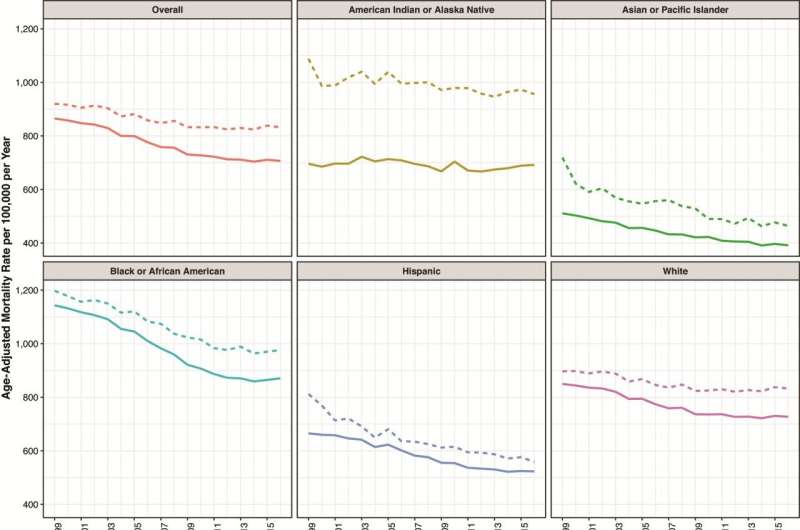This article has been reviewed according to Science X's editorial process and policies. Editors have highlighted the following attributes while ensuring the content's credibility:
fact-checked
peer-reviewed publication
trusted source
proofread
Study finds mortality rates among rural US residents vary based on race, ethnicity, region

Rural Black residents of the South have higher mortality, or death, rates than rural Black residents elsewhere, and so did Hispanic residents of the rural South and West, according to a new study by two researchers in the Penn State College of Health and Human Development.
These populations have higher mortality rates than their urban counterparts or people from the same ethnic/racial groups who live elsewhere. Rural residents across the United States have had higher mortality rates than urban residents since the late 20th century, according to U.S. census data.
The researchers found that this phenomenon, called the "rural mortality disadvantage," was not universal but varied based on race, ethnicity and where in the nation people lived.
Danielle Rhubart, assistant professor of biobehavioral health and demography, and Alexis Santos, assistant professor of human development and family studies and demography, conducted the study and published their results in a research note in Demography.
Public health improvements and treatment advances for cancer and heart disease in the 1980s and '90s led to reductions in the mortality rates in the United States as a whole, according to the researchers. In rural areas, however, mortality rates decreased at a slower rate.
Prior research by Penn State faculty and others documented this phenomenon at a national level, but Santos and Rhubart said they wanted to develop a more nuanced picture of who was experiencing the rural morality disadvantage.
The researchers examined all deaths in the United States from 1999 to 2016 using data from the Centers for Disease Control and Prevention's Wide-ranging Online Data for Epidemiological Research (WONDER) platform.
They cross-referenced the data with information from the National Center for Health Statistics to calculate age-adjusted death rates for every age group, broken down by region, racial/ethnic group and rural/urban residence.
The nation was divided into four regions—Northeast, South, Midwest and West—and five racial/ethnic groups were identified—American Indian or Alaska Native, Asian or Pacific Islander, Black, Hispanic/Latino and white.
For each racial/ethnic group, the researchers found the death rates were higher in rural areas than in urban areas. People who identified as American Indian or Alaska Native saw the greatest annual effect, with those in rural areas experiencing an additional 300 deaths each year for every 100,000 people compared to those who live in urban areas. Rural Hispanic residents were the least affected, with around 25 extra deaths each year for every 100,000 rural residents.
The rural mortality disadvantage was present for each racial or ethnic group at the national level, the researchers said, but things became more complicated when they examined each racial/ethnic population on a regional basis.
"In regions of the country with the largest share of an ethnic or racial group, we found those groups had higher mortality rates," said Santos.
Results showed that the rural mortality disadvantage for Black populations only existed in the South. Rural Black residents of the West, Midwest or Northeast actually had lower mortality rates than their urban counterparts, but 80% of rural Black individuals in the nation live in the South, according to U.S. census data. The mortality disadvantage in the South was large enough to create a nationwide mortality disadvantage for rural Black residents.
The rural mortality disadvantage was only persistent across all regions for white and American Indian or Alaska Native populations. Rhubart said that she was not surprised by the regional differences, as previous research from the Penn State Interdisciplinary Network on Rural Population Health and Aging had demonstrated that rural America is not a monolith.
"Our study built on that work to show that race, ethnicity and region all intersect to have very real impacts on people's health in rural America," said Rhubart, principal investigator of the newly formed working group on rural population health in the Social Science Research Institute. "To address the root causes of the rural mortality disadvantage, we must first understand how race, ethnicity and region all intersect with health and mortality."
Rhubart pointed to the complexity of these intersections and said that effective solutions will necessitate similar complexity, especially as many questions remain. Because their data ended in 2016, Rhubart and Santos are eager to learn how the COVID-19 pandemic may have affected these results and whether the impacts of the pandemic have lingered. Most of all, they said they want to understand the causes for the regional differences they detected.
"At this point, we have identified some important differences in mortality rates," Santos said. "The next step is for researchers to uncover what is driving these differences so that the underlying causes can be addressed. We want to see people across the nation living long, healthy lives regardless of their backgrounds."
More information: Danielle Rhubart et al, Research Note Showing That the Rural Mortality Penalty Varies by Region, Race, and Ethnicity in the United States, 1999–2016, Demography (2023). DOI: 10.1215/00703370-11078239





















